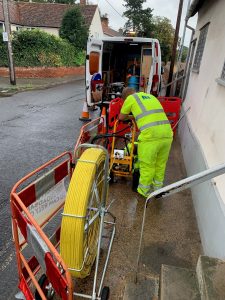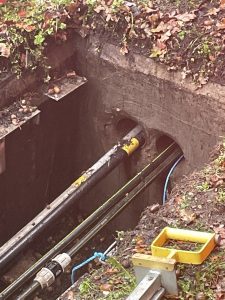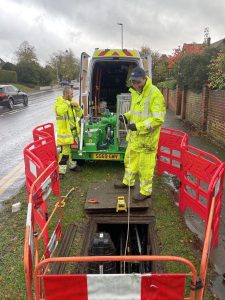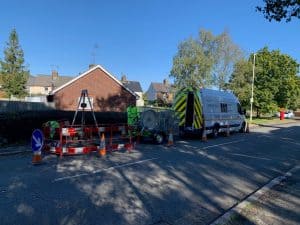Our fibre optic installation team have been busy with (TRR) test rod and roping and subduct installation. The work involves hard work installing multitube fibre optic subduct. This is largely due to congested existing ducts but with the right equipment and effort, great progress has been made.
Test Rod and Roping TRR
Supplied with the network diagram for the new fibre optic spine we set about to test rod and rope the existing ductwork. Proving the ducts is the first task this can be done manually or with the use of our duct rod / Cobra pusher.

Once through the blue rope is attached and pulled back ready to be used to pull in the fibre subduct. The duct routes can vary in length and date back in many cases to the 1950s. So they can already be packed with copper and fibre cabling.

The biggest problems that are encountered:-
- Congested Ducts with no room for new subduct to be installed
- Blockages that are encountered require proving both ways and attempted clearance raising A55 document when this is not possible and requires civils.
- Pits in roadways requiring Traffic management and the delays in getting this agreed upon and scheduled.
- Flooded Pits that require pumping out.
- Deep chambers require confined space entry trained installers to access the duct during installation.
Fibre Optic Subduct Installation
Once the duct is roped and proven clear then the team start installing the subduct specific to the contract. The fibre subduct is 25mm in diameter with 6 varying tubes to blow fibre down once the entire route is installed. Again the fibre optic subduct can be pulled in manually using a team of cable pullers which is time-consuming. Our method is to use the latest cable drum winches which reduce the risk of physical injury when pulling cable manually and speed up the operation.


The fibre subduct is pulled in the greatest length possible each time to reduce the number of joints. Once the fibre subduct route is completed it can then be jointed to provide continuous tubes. The fibre subduct is now ready for the fibre cable to be blown into it.